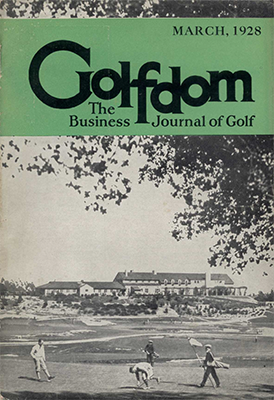The Golfdom Files: What a soil-tester will tell the greenkeeper
Some people are just ahead of their time, and H.S. Campbell, the author of this article from the March 1928 edition of Golfdom, certainly was ahead in the golf industry. Campbell was hoping for a product that could tell him the acidity or alkalinity of the soil on his green. The technology wouldn’t be available for years. Superintendents today have their choice of multiple products that can gauge soil salinity, moisture levels and temperature, while incorporating GPS and Wi-Fi technology. We don’t think even Campbell could’ve predicted all that.
By H.S. Campbell
 Would it be carrying this scientific “greenskeeping” business too far by making the following suggestion — that a record of the acidity or alkalinity of each green be kept through the playing season? A soil test made every week and posted on a chart should be very useful.
Would it be carrying this scientific “greenskeeping” business too far by making the following suggestion — that a record of the acidity or alkalinity of each green be kept through the playing season? A soil test made every week and posted on a chart should be very useful.
We have been told that greens thrive in an acid soil. But how acid? Does anyone know? A soil test of a fine green should answer that question.
One course will have beautiful, healthy greens while a neighboring course has poor, spotty and apparently ill-nourished greens, notwithstanding the fact that the care and treatment are practically identical on both courses. The following year, conditions may be reversed.
And when the misfortune of brown patch hits one or more greens, would not the exact knowledge of the acid or alkaline content of the soil of the diseased greens be beneficial? Compared with the soil of the unaffected greens, would this not help in avoiding this disease?
We are told that many factors must be considered in placing responsibility for brown patch. Amount and kind of water and time of day applied, drainage, air circulation, weather and other factors are blamed. Yet you will find greens placed in groves of trees, poorly drained and indifferently cared for, which are absolutely free of brown patch, while on an adjacent well-kept course, brown patch will be found on a well-drained green out in the open with no trees and plenty of air circulation.
As Alice said, it is all very confusing.
In the business world, charts and records of the past are recognized for their full value and are of inestimable help in planning for the future. And if golf course maintenance is not a business, what is it? Consider the money invested.
Making soil tests and posting results each week would be just one more job for harried greenkeepers, many of whom are expected to produce $20,000 results on an $8,000 or $10,000 budget. But I’ll bet a cookie that every one of them would keep this record if they were convinced it would help them keep their greens in better condition.
Many greenkeepers make a daily visual inspection of each green at an early hour. One day every week he can take with him one of the pocket soil-testers and make an absolutely reliable reading of each green in from two to five minutes. Eighteen times 5 minutes are 90 minutes, plus 10 minutes spent back at the barn or office in posting the chart, makes a time expenditure of one hour and 40 minutes per week.
The value of such a record would depend upon the individual keeping it, the regularity of the tests and the ability of the greenkeeper to draw conclusions from recorded facts.
One of the soil testing outfits that is being extensively used by some well-known greenkeepers is one that is profitably employed in water testing. Tests made of the city water used at the Beverly Country Club, Chicago, show an alkaline reaction of 8.0 on the “pH” scale. This necessitates use of a large amount of sulphate of ammonia or other nitrogen fertilizer to overcome the effect of the alkali in the water.
There is no set figure on the proper acidity figure. Observation of the figure on various greens that are in excellent condition determines an average that affords a safe working basis for the
greenkeeper.
Photos: Golfdom








